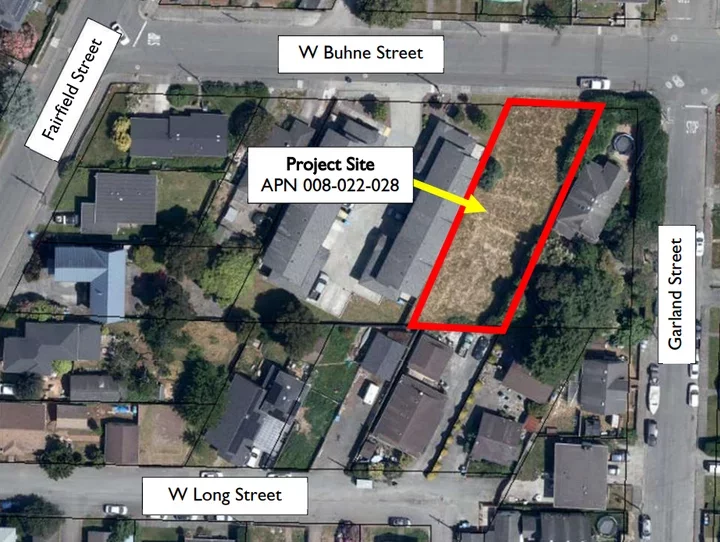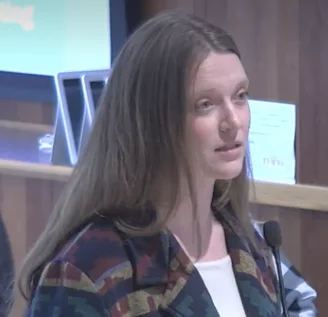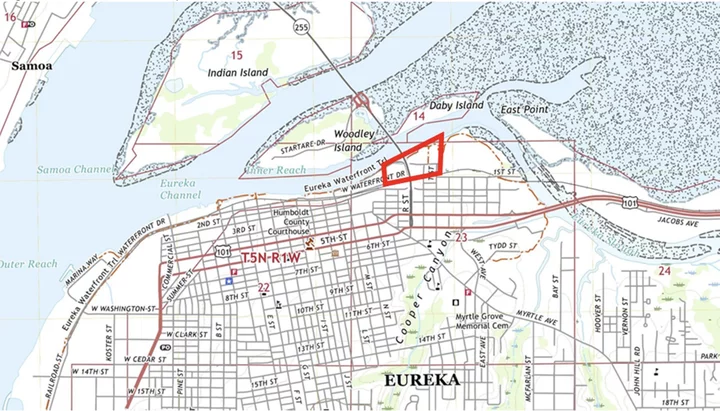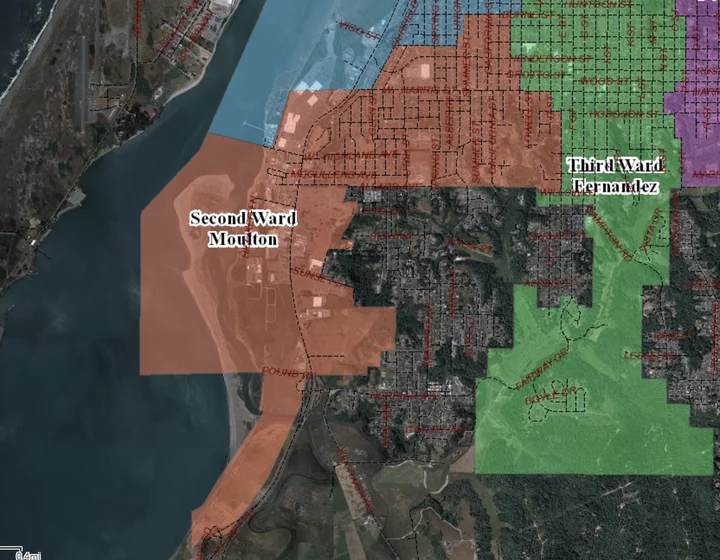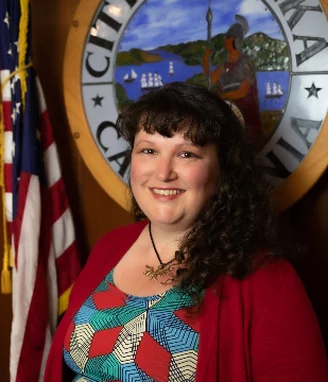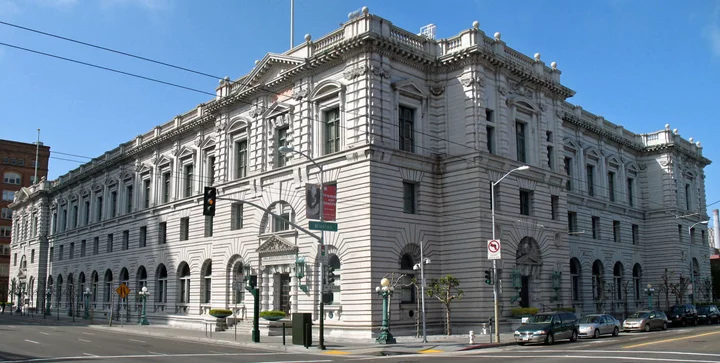(VIDEO) DEBATE WATCH PARTY: You Can View the Biden/Trump Debate Here
LoCO Staff / Thursday, June 27, 2024 @ 5:45 p.m. / Politics
Above: President Joe Biden and his predecessor, former President Donald Trump meet in the key battleground state of Georgia for their first debate of the 2024 election cycle, moderated by CNN’s Jake Tapper and Dana Bash.
BOOKED
Today: 7 felonies, 9 misdemeanors, 0 infractions
JUDGED
Humboldt County Superior Court Calendar: Yesterday
CHP REPORTS
2555 Harris St (HM office): Hit and Run No Injuries
1944 Central Ave (HM office): Trfc Collision-No Inj
1600 Mm36 E Hum 16.00 (HM office): Closure of a Road
ELSEWHERE
Times-Standard : Photo | Salty Santa arrives on the bay
Times-Standard : Photos | Humboldt Artisans offers up creativity
Times-Standard : Civic calendar | Humboldt County supervisors to discuss revoking permits over pot taxes
RHBB: Energy Expert: ‘A Lot of Uncertainty’ With Humboldt Offshore Wind Energy
Do You Know This Person, With Whom the Eureka Police Would Like to Have a Conversation?
LoCO Staff / Thursday, June 27, 2024 @ 5:03 p.m. / Crime
Press release from the Eureka Police Department:
On May 28th a prowler made access to a home on the 2800 block of Harrison Avenue in Eureka and was chased out by the homeowner. On June 21st the same prowler attempted entry at the same location. Once more, on June 27th the same prowler rang the victim’s doorbell at midnight/1am.
The Eureka Police Department is asking for help in identifying the prowler. Video is attached. If you have any information regarding this person, please contact Carly Michael at 707-441-4308.
Eureka Planning Commission Approves Contentious Five-Plex Development on Buhne Despite Neighbor’s Concerns
Isabella Vanderheiden / Thursday, June 27, 2024 @ 3:45 p.m. / Local Government
Rendering of the five-plex by Adams Commercial General Contracting Inc.
###
At last night’s meeting, the Eureka Planning Commission unanimously approved Adams Commercial General Contracting (ACGC) Inc.’s design plans for a five-plex on Buhne Street, overturning a recent, controversial decision by the Design Review Committee to deny the project.
The two-story building, slated for a vacant parcel near the corner of West Buhne and Garland Streets, will house five two-story units – one one-bedroom, three two-bedroom and one three-bedroom – each with their own garage.
The Design Review Committee denied the project at its May 8 meeting, due to the developer’s “inflexibility to work with the surrounding neighbors” to address concerns over “potential sunlight [and] shading issues” on an adjacent property.
One week later, ACGC filed an appeal, asserting that the “committee is precluded from denying a housing development project based on anything but objective standards” outlined in the California Housing Accountability Act (HAA). The committee’s decision was not based on “a conflict between the project and any applicable objective city general plan, zoning, or subdivision standard or criteria,” nor did it “identify a significant, quantifiable, direct and unavoidable project impact” based on objective public health and safety standards, according to the appeal.
Speaking at last night’s meeting, city planner Millisa Smith said ACGC’s proposal meets all of the city’s design standards and zoning requirements. The committee’s reasons for denying the project were not objective, she said.
“Although the [committee] tied their denial to a written code standard that the project would be detrimental to health, safety, or welfare or materially injurious to the properties or improvements in the vicinity, that written finding is subjective,” Smith said. “Applying it involves personal judgment.”
The neighbors, Stacia O’Neil and Dan Reid argued that the loss of sunlight would exacerbate the mold-prone nature of their 131-year-old Victorian home, putting their family’s health and safety at risk.
“California Health and Safety Code … says that when dampness or visible mold is in a home it’s a hazard to health,” O’Neil said. “I have an immunocompromised child who … will be affected greatly and dangerously by dampness. … Dampness causes mold to grow. Mold spores float through the air and land on wet and damp surfaces when they cannot dry out. … I have an earthen foundation, it would not be able to dry out.”
Reid’s concerns focused on the potential for fire danger. He suggested that ACGC “flip” the building to create more space between the five-plex and his home to provide more protection for everyone.
“We plead that you require the design to be flipped … to ensure my children have an adequate exit from our bedroom in case of a fire,” he said. “This is an easy way for the City of Eureka to eliminate any liability in a chance that my family is trapped in a burning building and not rescued because we have a four-foot [buffer] between our home and western property lines.”
Aerial view of the proposed development. Image: City of Eureka
Two other speakers echoed Reid’s request to flip the design, stating similar concerns.
Eureka resident Mitch Catching, on the other hand, questioned whether the neighbor’s concerns over shading and mold were valid.
“I looked at this piece of property and looked at the house next to it and … they have a hedge around their house that is over 20 feet tall in quite a few areas,” she said. “I don’t think in any spot is that less than 16 feet. … I think their concern about shade from this is a little overstated … given the size of the private hedge around this building.”
Catching urged commissioners to approve the development, adding that it would “set a very bad precedent” if the commission upheld the committee’s decision.
ACGC’s Real Estate Development Director & Community Liaison Raelina Krikston reiterated that the project adheres to the city’s established planning and zoning codes “in every way.” Krikston explained that flipping the building would create a “tunnel” between the project site and an existing multi-family development on the west side.
“It is a narrow parcel, and a third of it has to be taken up by a drive aisle for fire truck turnaround vehicle access,” she said. “It was less of an impact to move the project closer to the single-family home rather than, essentially, creating a tunnel between two multi-family units that would only have one viewpoint of each other’s windows. To be considerate to everyone in the neighborhood and make less of an impact for more families, this is how we chose to orient the project.”
Following public comment, Commissioner Michael Kraft made a motion to approve staff’s recommendation and overturn the previous decision by the Design Review Committee. The action was seconded by Commissioner Delores Freitas.
Kraft noted that he had spoken to staff before the meeting to find out if there is an objective or legally accepted standard that defines “materially injurious,” adding that “that’s where the homeowners have their best argument.” City Attorney Autumn Luna and Development Services Director Cristin Kenyon looked into it but determined all references to “materially injurious” were linked to “various city codes,” not case law.
“I’m not seeing objective criteria … to uphold the [Design Review Committee’s] denial,” he said. “I think our role here is … to try to understand the [city’s] code and the state law and apply them. While I might have personal feelings about flipping the property or other things, I’m not seeing anything to hang a hat on here.”
Commission Chair Meredith Maier agreed, adding that there are codes and bylaws that the Planning Commission must adhere to, even if it’s “not always in the neighborhood’s best interest.”
Freitas said she was sympathetic to the neighbors’ concerns, noting that “they’re not against the development and that they don’t think it will be bad for the neighborhood, in terms of new neighbors and multifamily housing.”
“I feel like this is one of those cases where more than one thing can be true at the same time,” she said. “It seems like the developer followed all of our rules and, in fact, could have made an even larger building … . I think it’s also true that it will have an impact to neighboring properties. … I hear what is being communicated by the neighbors about pouring their heart and soul into their home and it being emotional.”
Ultimately, Freitas felt that “this is sort of the direction our community needs to go” and said she was ready to approve the project.
The motion passed 3-0, with Commissioner Steve Lazar recused and Commissioner Craig Benson absent.
###
Commission Approves Waterfront RV Park
The future home of “Schneider RV Park,” east of the Samoa Bridge. Image: City of Eureka
The commission also approved permits and a lot line adjustment for a new RV park on Waterfront Drive near Halvorsen Park, with views of Humboldt Bay and Woodley Island.
The “Schneider RV Park,” named after the applicant and developer Travis Schneider, will be situated on a vacant parcel on the east side of the Samoa Bridge. The site will include 32 RV spaces (two of which will be ADA-compliant), associated utilities and hookups, 29 parking spaces, a walk-in tent camping area and a 2,000-square-foot office building.
Staff imposed nearly two dozen conditions of approval to ensure the project adhered to the city’s zoning code and Local Coastal Program. “There was a lot of thought going into this to make sure it complied with all of our regulations,” said Senior Planner Caitlin Castellano.
For example, staff decided to limit overnight stays at the RV park to 30 days or less and prohibit “any exterior improvements” to RV and camping sites (hot tubs, fencing, etc.) to ensure the site doesn’t turn into permanent housing.
Some neighbors raised concerns about trespassing and upkeep at the RV park. One resident, who only identified herself as Denise, said she would not trust the developer to maintain the property properly.
“The grounds at this point have not been maintained very well,” she said. “I have called code enforcement to have a futon and a camper shell removed and there’s been no action on that, no response via email or anything like that. I agree that there needs to be a barrier and good oversight … .”
She also expressed concern for the on-site camping area and asked how people staying at the RV park would be protected. “There are times that people are entering camps with knives and taking things and we don’t believe that that’s safe. We do not agree with that part of this project at all.”
There had been some discussion about putting a fence around the RV park as an added security measure, but Schneider said he has ultimately decided against it because it didn’t feel very welcoming to visitors.
“We wanted that community feel where people could, you know, co-mingle and interact,” he explained. “I would say I tell people this all the time: 20 hours out of the day I love the fact that we don’t have a fence … then there’s four hours out of the day that it presents a significant problem.”
Schneider said he wouldn’t be opposed to installing a fence, as long as it “doesn’t obstruct things.”
The commission ultimately approved the conditional use permit, coastal development permit, design review and lot line adjustment in a 4-0 vote.
Mariijuana Enforcement Team Busts Unlicensed Operation Off Avenue of the Giants, Agents Say
LoCO Staff / Thursday, June 27, 2024 @ 3:31 p.m. / Crime
Press release from the Humboldt County Sheriff’s Office’s Marijuana Enforcement Team:
During the month of May and June 2024, the Humboldt County Sheriff’s Office Marijuana Enforcement Team (MET) and Humboldt County Code Enforcement received numerous complaints regarding a property in the 5000 block of Hwy 254, Miranda. The Marijuana Enforcement Team (MET) was able to establish probable cause for a search warrant to be issued for the property. On June 27, 2024, deputies with the Marijuana Enforcement Team (MET), Humboldt County Code Enforcement and Department of Cannabis Control served the search warrant at the property.
One property was investigated during the service of the warrant. The parcel did not possess the required county permit and state license to cultivate and process cannabis commercially. During the service of the warrant, deputies seized and destroyed over 70.5 pounds of cannabis bud, 395.4 pounds of cannabis shake, and 77.9 pounds of Kief.
Additional violations with civil fines are expected to be filed by the assisting agencies. No arrests were made during the service of the warrant. The case will be forwarded to the DA’s Office for review.
Anyone with information about this case or related criminal activity is encouraged to call the Humboldt County Sheriff’s Office at (707) 445-7251 or the Sheriff’s Office Crime Tip line at (707) 268-2539.
Is There a New and Mysterious Contender for Eureka City Council’s Ward Two Seat? In Facebook Post, Local Realtor Calls for Help Finding a House to Buy Specifically in that Area ‘ASAP’
Jacquelyn Opalach / Thursday, June 27, 2024 @ 2:43 p.m. / Elections
Map of Ward Two in Eureka. Screenshot
This morning, local realtor Lauren Lazio issued an urgent call for help finding a three bed/two bath home to buy in Eureka’s Second Ward. The city council seat representing this area – which includes (parts of) Henderson Center and the neighborhoods surrounding the Eureka Mall shopping center – is currently filled by Kati Moulton, but it’ll be up for election this November.
“If you or someone you know has a nice house in ward 2 that isn’t currently for sale and want to sell it please contact as soon as possible!” Lazio wrote in a post to a 707 Classified Facebook page.
“Thank you in advance and hopefully we can find this awesome buyer a great house asap!”
Is someone – dare we suggest – ward shoppin’?
Reached by phone, Lazio said she has “no idea” why her client is seeking a home in this very specific location. Her Facebook post has since been removed.
If a city council campaign is indeed this mystery-buyer’s intention, the haste reflected in Lazio’s post is warranted. The filing deadline for Eureka council candidates is August 9th, and the average escrow period in California lasts around 30 to 60 days. The few days it would take for a seller to accept an offer, and for the house to be inspected and appraised, would leave around ten days of wiggle room.
The City of Eureka website clarifies that “a candidate must be a registered voter of the ward that they wish to represent at the time nomination papers are issued.”
Ward Two incumbent Kati Moulton wanted to give the hopeful buyer the benefit of the doubt during a brief phone call with the Outpost this morning.
“Maybe they just want to live in Ward Two because it’s a wonderful part of our community,” Moulton said. “I live there on purpose!”
But a run for the council position does seem to be what’s happening, the councilmember said. If that’s the case, Moulton added, this person is looking to “game the system.”
“It sounds like a power play by someone with more money than me,” she said.
The average home in Eureka is currently valued at $423,567, according to Zillow.
Moving to a specific area to run for office isn’t new to Humboldt politics. In 2022, Larry Doss moved to a property he owned in Orick full-time in part to qualify as a candidate for Humboldt County Fifth District Supervisor race, Doss told the Outpost at the time.
The upcoming Eureka council election will be a novel one. It will be the first to employ a ranked-choice voting system – in which voters rank candidates from most to least desired – a change that was approved by Eureka voters in 2020 and recently solidified by the City Council.
It’ll be interesting to see how ranked-choice voting shakes out given Eureka’s by-district voting system, which voters approved in the 2016 general election and requires folks to pick a representative who lives in their ward. In at-large elections, on the other hand, people may vote for anyone, regardless of their address. (Arcata does this.) In the 2020 election, 1,253 people voted in the Ward Two city council race.
No one has officially announced a campaign for the Ward Two seat, but Moulton indicated that she will run for reelection. She was elected to the council in 2020 in a race against three other candidates, and won by a large margin with more than 40 percent of the votes. Eureka’s Fourth Ward seat, currently occupied by Scott Bauer, will also be up for election in November.
For the time being, Moulton said she hopes her constituents are “seeing and appreciating” the work she does on their behalf. As far as a potential “carpetbagger” candidate in Ward Two? We’ll have to wait and see.
Zoellner’s Claims for Damages Against City of Arcata Shot Down in Court (Again)
Gillen Tener Martin / Thursday, June 27, 2024 @ 12:47 p.m. / Courts
Ninth Circuit court building in San Francisco. Photo: Sanfranman59, via Wikimedia. CC BY-SA 4.0 license.
DOCUMENT:
###
On Tuesday, the U.S. Court of Appeals for the Ninth Circuit in San Francisco sided with the City of Arcata and Arcata Police Department (APD) detective Eric Losey in the case of Kyle Zoellner v. City of Arcata.
After charges against Zoellner were dismissed in the case of Humboldt State University student David Josiah Lawson’s stabbing death in May 2017, Zoellner sued the City – including select officials and APD officers – on five claims: unlawful arrest, malicious prosecution, inadequate medical care (while in custody), a Monell (violation of federally protected rights) claim, and defamation (two separate instances of).
And initially, he won.
In Oct. 2022, a jury sided with Zoellner and ordered the City and Detective Losey to award him over $750,000 in damages, but U.S. District Court Judge Jacqueline Scott Corley overturned that order just days later.
This month’s appeals iteration of the case, heard in court on June 10, was Zoellner’s attempt to overturn the District Court decision to overturn the jury’s order.
The Ninth Circuit Court of Appeals stuck with Judge Scott Corley on Tuesday, finding that each of Zoellner’s five claims failed.
“Because the district court reached the correct result, we affirm,” the Court’s decision states.
The first two parts of Zoellner’s case, the unlawful arrest and malicious prosecution claims, turned on whether or not the APD had sufficient probable cause to arrest him as a suspect when officers arrived on-scene at a party early in the morning of April 15, 2017, to find Lawson stabbed. As the Circuit Judges wrote, proof of either claim would require a lack of probable cause, which requires a lower standard of evidence than a conviction.
The Court of Appeals found that the bar for probable cause in Zoellner’s arrest was met.
“Here, ample undisputed evidence supports a ‘fair probability’ that Zoellner may have committed the crime,” the Circuit Judges wrote. “Zoellner was identified by witnesses at the scene as the ‘stabber’ and his clothes were covered in blood.”
The Court also struck down Zoellner’s third claim – inadequate medical care – stating that while Zoellner was not immediately taken to the hospital by APD Officer Devon Nilsen, he also initially refused medical treatment.
“Shortly after Zoellner requested medical treatment, Officer Nilsen took him to the hospital,” the Court wrote.
The Ninth Circuit had two instances of defamation to consider. The first, against Arcata Police Detective Todd Dokweiler, concerned a statement Dokweiler submitted to the Humboldt County District Attorney’s Office saying that “other witnesses had seen Zoellner stab the victim” (despite the fact that no witness had identified Zoellner by name).
The second was against Police Chief Tom Chapman for his statement to press that “it was a white male who stabbed and killed a black male,” which led Chapman to think it was “prudent and logical to look at race as an issue.”
The Court struck down both claims, finding that Detective Dokweiler’s statement was protected under California’s litigation privilege (which protects statements made in the course of official duties and in judicial proceedings from claims such as defamation), and that there was no evidence proving cause and effect between Chief Chapman’s statement and Zoellner’s claimed damages.
“We agree with the district court that Zoellner suffered his claimed injuries ‘simply because of the charges that had been filed against him,’” the decision states.
On the final claim, the Monell (rights violation) claim, the Ninth Circuit Court of Appeals found it failed because it did not identify facts proving the City of Arcata and APD personnel had “final policymaking authority” over his prosecution or “knowledge of the alleged constitutional violation.”
“AFFIRMED,” the decision concluded, upholding the failure of Zoellner’s suit against the City and Detective Losey.
###
Disclosure: The author previously worked for the City of Arcata, beginning in 2019. She was uninvolved in the case this article covers.
###
PREVIOUS LoCO COVERAGE OF THE LAWSON CASE:
- Jail Records Reveal Name of Suspect in Fatal Arcata Stabbing
- Arcata Police Receive Anonymous Email Detailing Specifics of Arcata Homicide, Beg Author to Come Forward; Suspect Officially Named
- ‘He Was the One’: Josiah Lawson, Humboldt State Student and President of Brothers United, Remembered at Campus Prayer Service
- Zoellner Pleads Not Guilty to Arcata Stabbing Murder; Bail Set at $1 Million
- United by Tragedy, HSU Community Celebrates the Life and Mourns the Death of David Josiah Lawson
- ‘It Should Not Have Happened’: Friend of Arcata Murder Victim Believes Racism Delayed the Emergency Medical Response That Could Have Saved His Life
- ARCATA MURDER HEARING: First Witnesses Cast Doubt on Whether the Police Department’s Suspect Could Have Stabbed Victim; More Testimony Coming Tomorrow
- ARCATA MURDER HEARING: Witness Testifies That Lawson and Zoellner Were Grappling as the Victim Bled; Police Officer Describes Chaotic Crime Scene
- ARCATA MURDER HEARING: Friends Testify on ‘Girl Fight’ Between Lawson and Zoellner’s Girlfriends Prior to Fatal Stabbing
- ARCATA MURDER HEARING: More Testimony on the Knife Found at the Scene; Lawson’s Friend Testifies He Saw Zoellner Drop Something Shiny
- Judge Dismisses Case Against Kyle Zoellner, McKinleyville Man Arrested in Stabbing Death of HSU Student David Josiah Lawson
- Arcata’s Police Chief, Vice Mayor React to Zoellner Hearing Ruling
- ARCATA MURDER HEARING: Kyle Zoellner to Be Released After Judge Reinholtsen Rules Not Enough Evidence to Hold Him For Stabbing Death of Josiah Lawson
- (PHOTOS) Protesters March Through Arcata Demanding ‘Justice for Josiah’
- HSU Faculty, UPD, Brothers United Participate in Radio Town Hall on Lawson Case Tonight; Arcata Mayor Releases Statement; HSU Walk Out Planned Tuesday
- (PHOTOS/VIDEO) After Busy Week, Family and Friends of Josiah Lawson Still Seeking Justice
- Josiah Lawson’s Mother Offers $10k Reward for Information Leading to the Conviction of Son’s Killer
- Arcata Calls in Outside Investigators, Approves $21K Reward for Info Leading to Conviction of Lawson Killer
- Kyle Zoellner Appears in Court to Request Law Enforcement Return His Cell Phone, Laptops; Judge Says No
- (VIDEO) This Morning’s Lawson Murder Press Conference Offers Few Updates
- Public Investigator Working With APD in Josiah Lawson Case
- Kyle Zoellner, Once Suspected of Homicide in David Josiah Lawson Slaying, Files Claim Against City of Arcata For Defamation, Pain and Suffering, Emotional Distress
- (PHOTOS) Hundreds Turn Out for Eureka MLK Day People’s Rally and March for Justice
- DA: Grand Jury Declines to Indict Anyone in David Josiah Lawson Case
- (VIDEO) Justice for Josiah Activists Hold First Monthly Vigil Since Grand Jury Decision; Charmaine Lawson Vows to Keep Fighting
- ‘Justice For Josiah’ Advocates Demand Arcata City Council Turn Lawson Case Over to the State
- Arcata Police Release Images of Potential Josiah Lawson Stabbing Witnesses, Ask Public’s Help
- TWO YEARS
- (WATCH) ‘Who Killed Josiah?’: Documentary Takes a Look at the Lawson Case
- California Attorney General’s Office Says it Will Not Take On Josiah Lawson Case
- ‘Racism Kills!’ Supervisor Bohn Adjourns Meeting and Leaves Chambers Amid Outcry Over Derogatory Joke
- Humboldt High Schoolers Announced as First David Josiah Lawson Scholarship Recipients
- Josiah Lawson Documentary Set to Air on Los Angeles Television Later This Month
- (AUDIO) Charmaine Lawson, Arcata Police Chief Ask Witnesses to Josiah Lawson Slaying to Come Forward in Public Service Announcement.
- (VIDEO) ‘Justice for Josiah’ Activists Shut Down Arcata City Council Meeting
- Outside Review of Lawson Case Complete; Emergency Response Deemed Appropriate But More Training Recommended
- On the Third Anniversay of Josiah Lawson’s Death, Arcata Police Once Again Ask for Witnesses to Come Forward
- (VIDEO) Charmaine Lawson Interviewed for TV Documentary Series ‘Still a Mystery’; Episode on the Murder of HSU Student Josiah Lawson to Air Tonight
- Civil Grand Jury Finds ‘Failures’ and ‘Ineptitudes’ But No Direct Evidence of Racial Bias in Review of Josiah Lawson Homicide Investigation
- Submissions Sought for David Josiah Lawson Oration Festival
- Charmaine Lawson Settles Lawsuit Against City of Arcata; Terms Include $25,000 Contribution to Scholarship Fund, New City Mural and Additional, Undisclosed Terms
- Eureka City Schools Board Overturns Mural Ban, Making Way for BIPOC Student Art
- Five Years
- Charmaine Lawson Continues to Seek ‘Justice for Josiah’ Five Years After Her Son’s Death
- ZOELLNER v. ARCATA: Kyle Zoellner’s Attorney Attempts to Revive Claim for Damages Against the City of Arcata at the Ninth Circuit Court of Appeals
Grand Jury Analysis Shows That County Government Has a Hell of a Time Trying to Hire Qualified Employees and Offers Some Simple Suggestions
LoCO Staff / Thursday, June 27, 2024 @ 11:07 a.m. / Local Government
DOCUMENT:
###
Press release from the Humboldt County Grand Jury:
The Humboldt County Civil Grand Jury has released the fifth report of their 2023-2024 term, entitled Humboldt County Hiring: Status, Process, and the Future.
Understaffing in Humboldt County government is systemic, appearing in all departments, and affects how well or poorly our county government serves the public. The Humboldt County Civil Grand Jury investigated county hiring practices, finding that understaffing is one of our largest challenges, that the causes are many, and that while there may be no complete solutions, there are things the county can do to help.
We reviewed current hiring processes for the three largest Humboldt County employee groups: The Sheriff’s Office, the Department of Health and Human Services, and the Department of Public Works. These three entities employ approximately seventy percent of county employees and account for a majority of the county’s general fund budget. As of April 2024, approximately 500 of the 2400 currently allocated positions were vacant.
We did a statistical comparison with six other Northern California counties of similar population to get an idea of where Humboldt County stands, finding we have a vacancy rate of twenty-one percent, second highest in our survey, and an employee retention rate of eighty-four percent, average for all but two of the counties in our survey. The survey also revealed that all the counties are struggling with the same hard-to-fill positions such as Social Workers, Deputy Sheriffs, Correctional Officers, and Engineers.
Challenges to recruitment and retention are not limited to financial considerations like salary and benefits. The length of time from recruitment to onboarding can be an obstacle to hiring, and the requirement to use the services of the California Department of Human Resources for some of the hardest to fill positions is a major impediment. A relative lack of recruitment and retention tools and incentives is another factor.
Crucially and ironically, Humboldt County Human Resources is itself understaffed. As of April of 2024, two of the eighteen allocated positions were unfilled. Three positions are funded by a COVID- era federal grant that expires in the summer of 2024, leaving just fifteen funded positions. Widely accepted industry standards call for a County of our size to have about twenty-five people in Human Resources.Certain hiring practices vary by department, with some departments having been more proactive than others in recruiting and shortening hiring timelines. Unlike the other counties surveyed, Humboldt County Human Resources does not have a single Policies and Procedures manual, instead relying on informal guidelines and a collection of documents and PowerPoint slides. No standard metrics to measure county-wide hiring success or internal performance of the hiring steps exist, and the use of annual performance reviews is inconsistent.
It is the conclusion of the Humboldt County Civil Grand Jury that bold, sweeping ways to address these issues, such as raising salaries and improving benefits packages, are not practical given Humboldt County’s financial situation. There are, however, many small, inexpensive, and relatively easy to implement things that can be used to make hiring and retention faster, smoother, and more effective. These recommendations and much more information can be found in our report.
The 2024-2025 term for the Civil Gand Jury is right around the corner, and the Superior Court is seeking more jurors. If you want to serve your community in a unique way that could improve local government this is your opportunity. Applications to serve on the Humboldt County Civil Grand Jury can be found at this link. Additional information provided by the Civil Grand Jurors Association of California can be found at this link.


